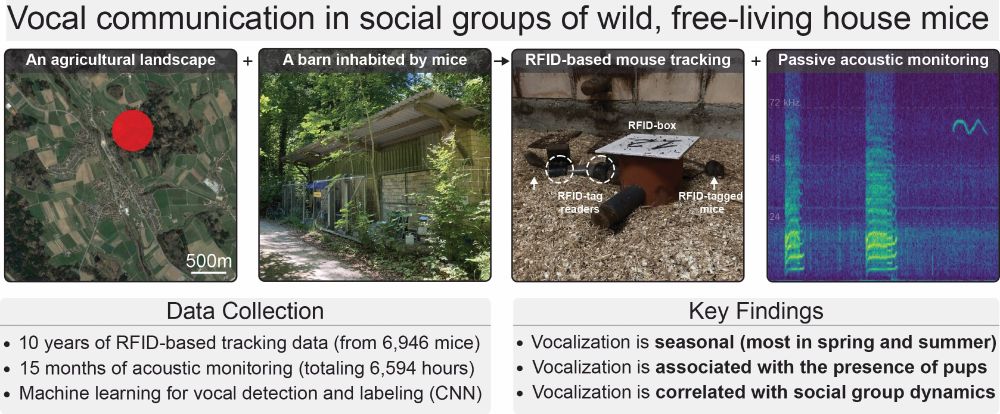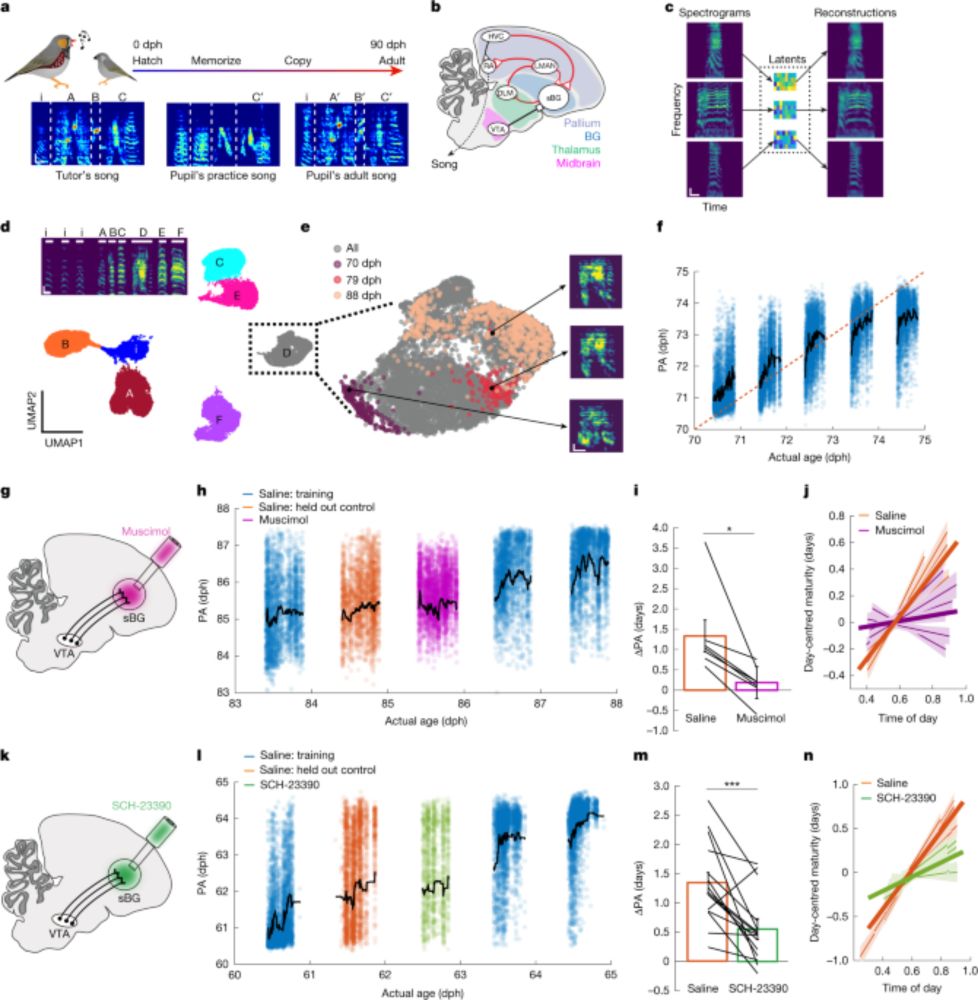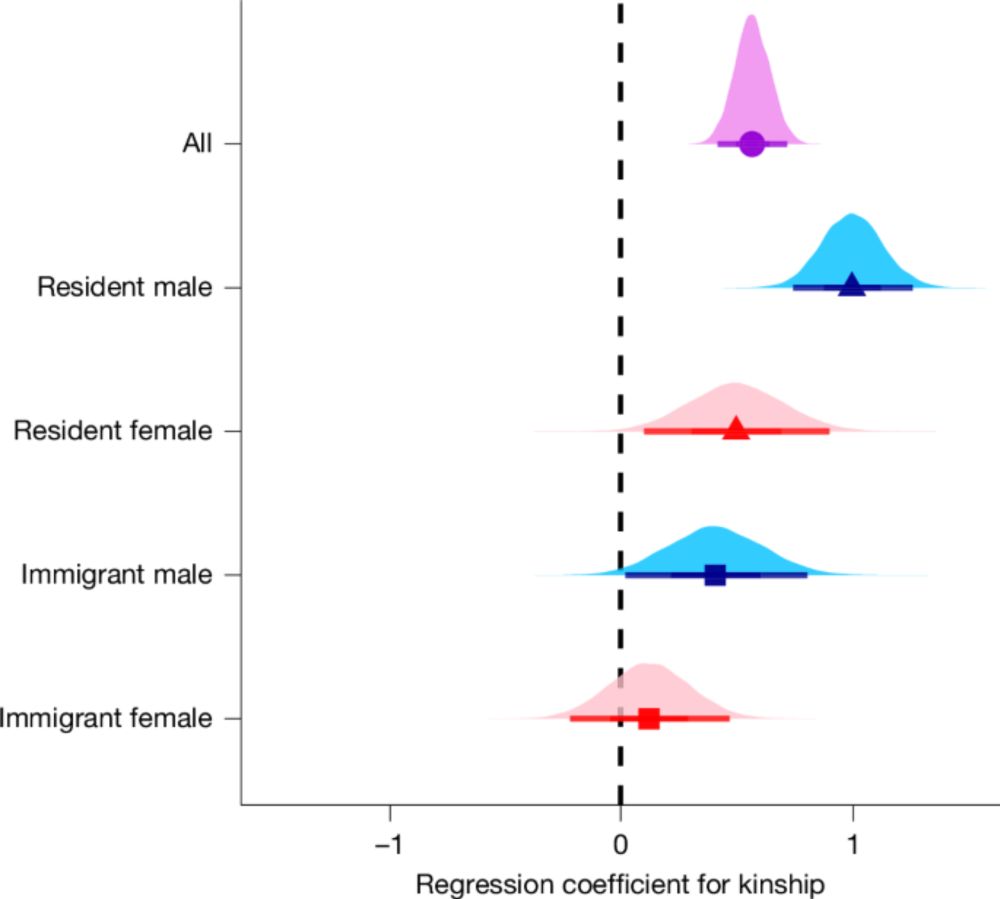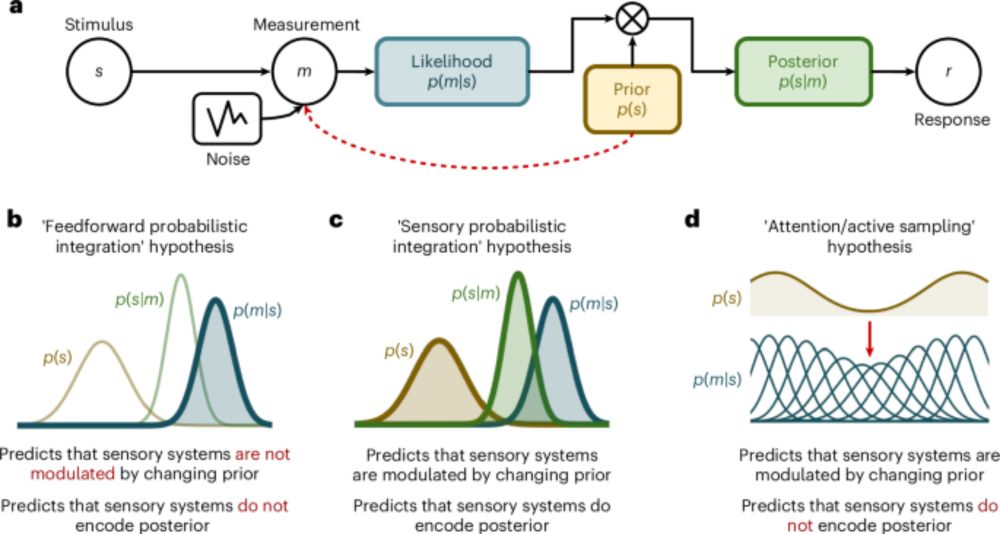🧠🌟🐭 Excited to share some of my postdoc work on the evolution of dexterity!
We compared deer mice evolved in forest vs prairie habitats. We found that forest mice have:
(1) more corticospinal neurons (CSNs)
(2) better hand dexterity
(3) more dexterous climbing, which is linked to CSN number🧵
22.10.2025 20:41 — 👍 328 🔁 109 💬 16 📌 18

Postdoctoral Research Associate - Biology
Position Summary A postdoctoral position is available in the laboratory of Dr. Andreas Kautt in the Department of Biology on the Danforth Campus at WashU in St. Louis. The Kautt Lab studies the mechan...
Reposting this open postdoc position with more detailed specifications. Couldn't find the right fit in the first round—not due to lack of strong candidates, but because we're looking for someone whose expertise matches a specific project. More details in the job ad. Apply!
tinyurl.com/2uskxyrp
03.10.2025 22:05 — 👍 12 🔁 22 💬 0 📌 0

Me with my poster on the greylag goose vocal repertoire and how data representation types influence the predictions of unsupervised methods
Thank you to everyone at #ibac2025 for this amazing conference. I met so many great people and learned a lot about so many interesting projects. Excited to see you all again some time! And proud that my poster got the student poster price ☺️ stay tuned for the publication!
14.09.2025 05:24 — 👍 23 🔁 7 💬 2 📌 0
 04.09.2025 10:07 — 👍 37 🔁 58 💬 1 📌 1
04.09.2025 10:07 — 👍 37 🔁 58 💬 1 📌 1
The psych job market may not be dead... but it is gravely injured 😬 So far it's looking like the Trump administration's attacks on higher ed/research are going to have more than 2x the impact on the job market as the covid-19 pandemic. #psychjobs #neurojobs #academicjobs
03.09.2025 18:27 — 👍 163 🔁 73 💬 14 📌 10
⭐ Long-term support: Actively maintained for 6+ years, 1700+ stars on GitHub, hundreds of citations (even without a paper!)
🐦 We also release Birdsong NOIZEUS, a new benchmark for bioacoustic denoising
02.09.2025 18:54 — 👍 0 🔁 0 💬 0 📌 0
✅ Domain-general: strong baseline when ML models/data aren’t available
🎛️ Stationary & non-stationary variants
⚡ GPU-accelerated for real-time and high-throughput use
🧪 Validated across many domains
02.09.2025 18:54 — 👍 0 🔁 0 💬 1 📌 0

Domain general noise reduction for time series signals with Noisereduce - Scientific Reports
Scientific Reports - Domain general noise reduction for time series signals with Noisereduce
New paper out today with Asaf Zorea : "Domain-general noise reduction for time-series signals with Noisereduce" (open access)!
We present Noisereduce, a lightweight Python library for denoising signals.
Read the paper: doi.org/10.1038/s415...
Code (library): github.com/timsainb/noi...
02.09.2025 18:54 — 👍 13 🔁 4 💬 1 📌 1
🚨Very happy that my PhD work is now out in @nature.com!
We discovered that evolution, by acting in the midbrain, shifted the threshold to escape in Peromyscus mice, to fine-tune defensive strategies in different environments
www.nature.com/articles/s41...
This was a truly collaborative effort! 🧵⬇️
23.07.2025 15:05 — 👍 469 🔁 102 💬 26 📌 5

Graphical abstract for "Vocal communication is seasonal in social groups of wild, free-living house mice."
The abstract has, from top to bottom, a title, four middle image panels, and two bottom text panels.
Image title: "Vocal communication in social groups of wild-free living house mice"
Middle image panels from left to right: (1) An aerial snap shot of the region where the study site is located, an agricultural landscape in rural Switzerland. (2) An image of the study site, a small barn in the forest inhabited by mice. (3) An image of a radio frequency identification (RFID) box used to track mouse social interactions. A mouse is entering the box from the left while another sits outside. (4) A spectrogram showing example vocalizations - one low frequency squeak and one ultrasonic call - recorded from an RFID box.
Bottom panels:
Left: Data Collection
- 10 years of RFID-based tracking data (from 6,946 mice)
- 15 months of acoustic monitoring (totaling 6,594 hours)
- Machine learning for vocal detection and labeling (CNN)
Right: Key Findings
- Vocalization is seasonal (most in spring and summer)
- Vocalization is associated with the presence of pups
- Vocalization is correlated with social group dynamics
Very happy to share the latest from my postdoc!
10 yrs of mouse social networks + 1.25 yrs of acoustic data ➡️ insight into vocalization & sociality in a wild population of your favorite lab model 🐁
paper: bit.ly/4n93yyD
data: bit.ly/4lfFBEk
code: bit.ly/4kNnMwx
#bioacoustics #neuroskyence
1/8
18.06.2025 18:25 — 👍 135 🔁 47 💬 4 📌 8


https://www.sarasotamagazine.com/travel-and-outdoors/2020/08/dolphin-watching-tour-sarasota
1/8 Decoding Dolphin Communication
After studying 313 dolphins (in Sarasota, Florida) for over 40 years and across six generations, a catalog of their vocalizations has been produced.
These vocalizations are more complex than expected.
(preprint) www.biorxiv.org/content/10.1...
09.05.2025 15:15 — 👍 22 🔁 10 💬 2 📌 0

Expectation-driven sensory adaptations support enhanced acuity during categorical perception - Nature Neuroscience
Bayesian models explain how context biases perceptual behavior toward expected categories, but sensory neurons do not reflect this bias. Instead, expectation sharpens sensory acuity, independent of do...
Very cool @danielpollak.bsky.social @healeylab.bsky.social - this aligns with what I found in the starling paper we just published using a different context paradigm (sequence integration). NCM (among others) also does not show context modulation but sharpens acuity/attn with expectation
08.04.2025 19:29 — 👍 8 🔁 1 💬 1 📌 0

Cosyne 2025 - Session 9: Building blocks of cognition
YouTube video by Cosyne Talks
My talk at COSYNE is up: "Discrete actions are a unit of both behavior and evolutionary selection" with @akautt.bsky.social and @dattalab.bsky.social www.youtube.com/live/Y8Ke6HC...
30.03.2025 15:51 — 👍 41 🔁 12 💬 5 📌 1

Sensory populations reflect the Bayesian likelihood. And expectation modulates sensory activity. But here’s the twist: sensory neurons don’t integrate the likelihood and prior expectation. (6/n)
17.03.2025 15:05 — 👍 2 🔁 1 💬 1 📌 0
Finally, this work is the product of an amazing team, in particular @trevorsupan.bsky.social and Tim Gentner! And a huge thank you to our reviewers and everyone who provided feedback throughout!
17.03.2025 15:05 — 👍 3 🔁 0 💬 0 📌 0
This was the longest project of my career! It started nine years ago, back in 2016, the second year of my PHD. Every paper I have ever published has been enveloped by this one.
17.03.2025 15:05 — 👍 3 🔁 0 💬 1 📌 0
Takeaway:
1) Song sequence perception follows Bayesian integration.
2) Sensory populations reflect the likelihood, and are modulated by expectation, but don't follow Bayesian integration.
3) Instead, expectation refines sensory precision, leaving an unbiased signal for downstream processing.
17.03.2025 15:05 — 👍 3 🔁 0 💬 1 📌 0
This challenges the idea that sensory neurons integrate prior expectations the way decision-making circuits do. Instead, expectation boosts acuity where needed, letting decision-making systems flexibly integrate an unbiased sensory signal. (8/n)
17.03.2025 15:05 — 👍 2 🔁 0 💬 1 📌 0

Instead of integrating expectations, neural populations enhance the likelihood of expected stimuli—sharpening perception rather than shifting it.
This means sensory systems maintain a veridical, faithful, representation of the world. (7/n)
17.03.2025 15:05 — 👍 2 🔁 0 💬 1 📌 0

Sensory populations reflect the Bayesian likelihood. And expectation modulates sensory activity. But here’s the twist: sensory neurons don’t integrate the likelihood and prior expectation. (6/n)
17.03.2025 15:05 — 👍 2 🔁 1 💬 1 📌 0

Behaviorally, birds integrate expectations and sensory input probabilistically, following a Bayesian strategy. This aligns with classic models of categorical perception. 5/n
17.03.2025 15:05 — 👍 1 🔁 0 💬 1 📌 0

To investigate this, we trained European starlings to classify ambiguous song syllables generated from a variational autoencoder. We manipulated expectation by changing the probabilities of syllables within song sequences. 4/n
17.03.2025 15:05 — 👍 2 🔁 0 💬 1 📌 1

We show that while decision-making systems integrate expectations probabilistically, sensory systems do something surprising: Rather than biasing perception, expectation sharpens it, enhancing sensory precision. 3/n
17.03.2025 15:05 — 👍 3 🔁 1 💬 1 📌 0

On one hand, we use expectations to pull experience into expected perceptual categories, stabilizing perception but *reducing acuity*. On the other hand our expectations allow us to focus our attention on relevant signals, *improving acuity*. 2/n
17.03.2025 15:05 — 👍 2 🔁 0 💬 1 📌 0

Dual neuromodulatory dynamics underlie birdsong learning - Nature
Dopamine release in the basal ganglia of the zebra finch is driven by neurons associated with reinforcement learning and by cholinergic signalling, and tracks performance quality during long-term lear...
Proud to have contributed to @jiaxuanqi.bsky.social's masterpiece out @nature.com! She shows that dopamine transients track the learned quality of song during juvenile learning and that dopamine release is driven not just by VTA firing, but by a local cholinergic mechanism! (1/x)
12.03.2025 16:54 — 👍 116 🔁 35 💬 2 📌 7
OK If we are moving to Bluesky I am rescuing my favourite ever twitter thread (Jan 2019).
The renamed:
Bluesky-sized history of neuroscience (biased by my interests)
01.12.2024 20:29 — 👍 604 🔁 201 💬 14 📌 14
Animal communication, neuroethology
Postdoc @MPIBR
Naked-mole rat research 🍠
Scientific illustrator: behance.net/alem3
into brain evolution & development, open science, art & science https://www.youtube.com/watch?v=6hMNZHsrNHw, music, making, javascript, contemporary dance https://www.youtube.com/watch?v=OZfHj7F2FzQ
website: katjaq.github.io
Neural circuits, instinctive behaviors and evolution @nerflabs.bsky.social and Dept of Biology, KU Leuven.
see: farrowlab.sites.vib.be
Assistant prof at UIUC interested in memory and how neural representations evolve over time.
https://climerlab.org
sensory systems, evolution of behavior and cross-kingdom interactions, special interest in insects and kin 🪰🪲 | postdoctoral fellow at Bellono Lab, Harvard MCB | PhD from @GallioLab | he/they 🏳️🌈
#NIHMOSAIC K99/R00 scholar using comparative genomics to understand the molecular basis of innate mating & parenting behavior in deer mice 🧬 🐭
Born curious, trained scientist; Interested in Sensory Biology, Evolutionary Biology & Genomics; Dad ; Belgian returnee (former 🇸🇪🇺🇸); PI @GIGA_ULiege 🇷🇴
https://www.gigaevoneuroetho.uliege.be
Natural behavior, brain evolution, & ecological change, with a focus on wild 🐭 and 🦎. Currently a Postdoc @mpibrain.bsky.social; PhD from @harvardmcb.bsky.social. he/him
felixbaier.github.io
Voss Postdoctoral Fellow at the Institute at Brown for Environment and Society. I study chorusing strategies in frogs and their social and physiological drivers.
Personal Website: https://t.co/MUzk1rI1em
Assistant Professor, Environmental Studies, NYU
Primatologist, Author of THE ARROGANT APE
https://www.cewebb.com
PhD student researching animal behaviour, cognition, and communication |
Interested in avian rhythm and “dance” 💃🏻🕺🏼|
Love music, nature, bouldering, and exploring wild places 🌴 |
he/him |
University of Veterinary Medicine, Vienna
Birds, Brains, and Behavior | @mpinb.mpg.de & Undergrad @IIScBangalore
PI @Rockefeller University. Investigator @HHMI. Instigator of clonal raider ant project #CRAP. 🐜 Evolution, Behavior & Neuroscience. Posts science and photography. 🧠 📸
https://www.rockefeller.edu/research/2280-kronauer-laboratory/
Hello, we are the Animals Doing Stuff in Groups lab, PI @mikemwebster.bsky.social at the University of St Andrews. We study animal behaviour and social interactions.
🐟(🐚🦀)🐧
https://sites.google.com/view/big-lab-webster/home?authuser=0
Ecologist (invasive species, freshwater biodiversity, bioinvasions, aquatic ecosystems) | Professor of Biology, McGill University | Director of the Bieler School of Environment | My lab account: @ricciardilab.bsky.social
PhD student at University of Vienna studying female birdsong and duetting
Professor of Genetics and Pediatrics, UPenn/CHOP🧬. https://orcid.org/0000-0003-2025-5302. Views my own. 🏴🇺🇸
Proud father of two wonderful kids.
Professor of sensory circuits and neuro-imaging, fMRI, layers, auditory perception, computational cognitive neuroscience


 04.09.2025 10:07 — 👍 37 🔁 58 💬 1 📌 1
04.09.2025 10:07 — 👍 37 🔁 58 💬 1 📌 1

















